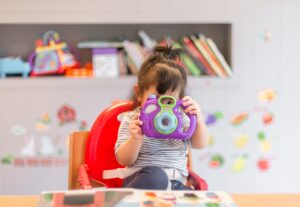Dare to be a rebel… again

© Tanaphong Toochinda (2018) CC0
At the UCD Gathering conference last week, Laura Yarrow’s talk on rebellious creativity was a definite highlight for me. She talked about what we can learn from children’s rule-ignoring, rebellion-embracing ways to improve our ideas, creativity and ways of working.
A story about her 5-year-old son summed it up well. When frantically searching for an egg cup at silly o’clock in the morning to make breakfast, he calmly reassured her that she could stop looking because there was one right in front of her… pointing at a candlestick. Sturdy, the right shape, resistant to egg stains, a perfectly sound alternative!
So, why didn’t Laura see the candlestick as the perfect egg receptacle? Functional fixedness. This is the way that most adults view the world. Unlike children, we tend to limit ourselves to use an object in the one way it was designed to be used.
I think we would all benefit from having a bit more rebellious creativity in our lives – experiment with new ideas, dare to be different, and don’t be afraid to make mistakes. We should all be encouraging each other to do it more too!
The next time you’re discussing ideas with colleagues, why not use the Rebel Innovation Toolkit? It will help you to shake things up… in a good way. Channel your inner (rebellious) child!
The creative adult is the child who survived. – Ursula K Le Guin
Rebel Innovation Toolkit
1. Beginner’s mind
Adults make decisions based on rules, habit, and social judgement, whereas kids don’t care about the way something has been done before, the way they did it yesterday, or what other people think. They’re always experimenting to learn about the world, and innovation is continuously born out of that process.
In a variety of studies to compare the behaviour of adults and children, the result is always the same. Adults spend most of the time worrying about power, control, and discussing the task… a lot. Children, on the other hand, use short, direct language, are quick to try things out, and focus on the aim of the task.
Leaving your expert mindset at the door allows you to focus on the objective and get the best results. If you ask a group of children to build a tower, all their actions and discussions contribute towards building the best tower possible (they don’t care who the CEO of Towerbuilding Ltd. is!)
2. Ask questions
Whatever you’re designing or developing, when a project is underway, it is easy for deadlines to become the sole focus. It might feel counterintuitive, but pausing to question things will not only help improve the overall end product, but can actually save you time.
Ask questions at every stage of the project, and try to have an open mind if you’re the one answering them. Questioning what we’re doing and why is essential for improvement, and to check that what we’re doing is actually necessary and the best use of time. Be curious, don’t be afraid to look silly, and don’t make other people feel silly for asking!
3. Strategic procrastination
Procrastination is your friend… if it’s strategic! While it’s rarely the best idea to put something off till the very last minute (I’m not judging!), having time to mull things over has a positive impact on the quality of your input.
Give your lovely brain time to go into diffuse mode (a relaxed thinking state). This will help you get perspective on things, and come up with solutions organically, rather than forcing yourself (in focused mode) to find all the answers straight away. Basically, spending time on the epiphany toilet will do you wonders!
4. Connective inquiry
Children are rarely hesitant about asking questions… Why is that?… Why?… Why?… Why?… But why?… Why?
We could all benefit from building more time into project development for ‘question storming’, where there is no judgement about what we ask, we can be free to be curious, and we can remove the pressure to generate ideas.
It has been shown that groups of adults think more openly and creatively when they’re involved in this process. They tend to be open and non-judgemental towards questions, but harsher when presented with answers and statements.
5. Embrace diversity
It might not feel like it, but conflict and differences of opinion can be constructive and promote innovation. It can be tempting to take things personally if your ideas are questioned or challenged, but doing this in a friendly way should be encouraged amongst teams. Diversity is the key to creativity and although friction isn’t usually a good thing (unless you’re trying to get a fire going), creative friction is! Try thinking so far outside the box that the box is a dot to you (don’t worry, it’s still there if we need it).
6. Volume then quality
It is common for a group of adults to settle on one idea quite quickly, often the first one. Everyone nods in agreement, and that’s that. But prolific creators actually produce lots and lots of ideas of varying quality (not everything Beethoven wrote was amazing. Wait…)
If you have freer, idea-generation sessions to churn out lots of options, then select the best ones from that bigger bunch, the overall quality will be improved.
(© Tanaphong Toochinda (2018) CC0)




oooooh “Strategic procrastination” banked to be used later, when I’m not procrastinating.